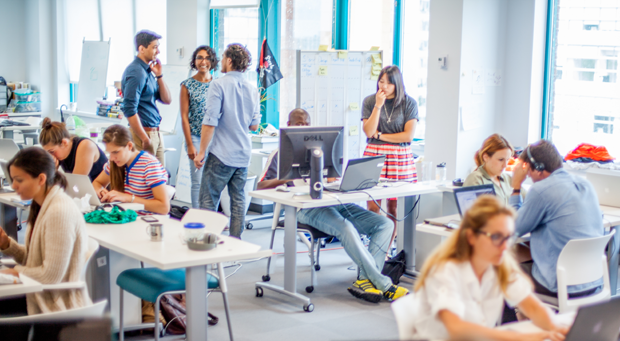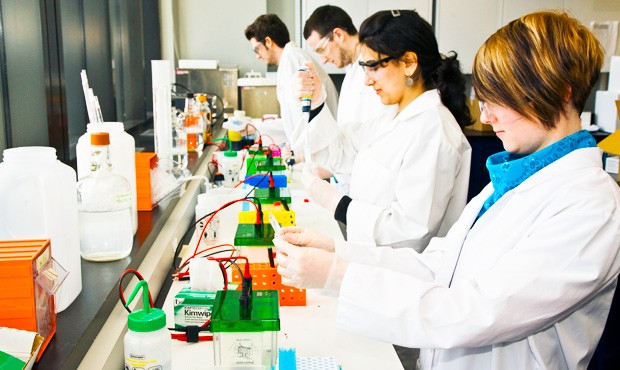‘We need to be agile in our growth and priorities’

“Our goal is to make Concordia a beacon of what a next-generation university should look like,” says Graham Carr, provost and vice-president of Academic Affairs.
“Any progress we make depends on the success of our students and faculty — a vital element for us to move forward under our nine directions.”
If 2016-17, year one of implementing the “first moves” under the university’s Strategic Directions Game Plan, is any indication, Concordia is well-positioned for future success.
“The accomplishments of our first year were quite breathtaking. They reflect a lot of hard work across all faculties, the School of Graduate Studies and the Concordia Library,” Carr said in his update at the October 13 Senate meeting.
The nine directions, developed through consultation across the university, clearly distinguish Concordia and have galvanized the community into action, he added.
“In 2016-17, we saw a remarkable level of engagement. There was no shortage of great projects or ideas. Part of our challenge in year two will be to find focus and harness this energy.”
5 guiding principles
To support the decision-making process in 2017-18, Carr identified five guiding principles: position globally, partner meaningfully, integrate for impact, deliver on innovation and augment the student experience.
Concordia’s reputation worldwide continues to rise, with rankings serving as one indicator.
“We are among the world’s top 1.6 per cent and we are the top-ranked Canadian university under 50 in Canada and tied for top spot in North America,” he said, referring to the Quacquarelli Symonds (QS) rankings.
“These are an important driver of our reputation within an increasingly competitive global environment.”
To succeed in the 21st century, Carr also believes you have to partner effectively.
“Our relationship with Hydro-Québec — which has generously supported our students, the Solar Decathlon project, and three Industrial Research Chairs — is a partnership that has matured.”
Integrating activities for maximized impact will also be key in 2017-18, said Carr. He cited the new Science Hub, to be located on the Loyola Campus, as an example.
This state-of-the art facility will encourage interdisciplinary collaboration and research. It will host cross-disciplinary science and engineering research and link to startup opportunities through new wet lab space for Concordia’s District 3 Innovation Center.
“We want to deliver on innovation, a critical element of being a next-generation university,” he added.
“One initiative we plan to launch focuses on nurturing the talent and expertise of our staff members through a new suite of training programs in fields such as project management.”
As a next-generation university, enhancing the student experience also remains an important priority for Concordia.
“There are many ways of doing so — some will happen in the classroom, while others will focus outside our corridors, such as through experiential learning,” said Carr.
Both the renovation project to support a new Student Success Centre and the Webster Library Transformation Project are tangible examples of how the university is making good on its commitment to augment the student experience.
“Undergraduate and graduate students now have access to more than 3,000 study seats and a state-of-the-art technology sandbox.”

What’s next in 2017-18
Work in the upcoming year will focus on five transformation projects with a sustained commitment to addressing the Truth and Reconciliation Commission (TRC).
Carr noted that the Indigenous Directions Leadership Group, created in late 2016, has made great strides toward raising community consciousness. Next spring, it will deliver a series of recommendations on priority actions that the university can take to improve its responsiveness to the TRC’s Principles and Calls to Action.
“I want to emphasize that the work of reconciliation involves all of us,” said Carr. “For Concordia to be a leader, we all have a role to play in developing a meaningful university-wide response to the commission.”
Key initiatives undertaken in 2016-17 include:
- The articulation of a territorial acknowledgement, which is an expression of respect for Indigenous peoples as the traditional custodians of the land on which the university is located
- Welcoming an elder to the Concordia community
- Hiring a student recruiter to focus on attracting potential students to Concordia
- Securing approvals to hire a coordinator to liaise with Indigenous communities and a curriculum developer with a focus on Indigenous curriculum
An Indigenous Directions digital hub was also recently launched, which centralizes information about the Aboriginal Student Resource Centre (ASRC), research and community-based projects, as well as profiles of Indigenous students, alumni and faculty members.
A health institute, summer schools and more
The university has identified five transformational projects that it will launch in 2017-18:
- The development of a health institute, leveraging the fundamental and applied research being done by various researchers and research groups in all four faculties
- Montreal 2050, a hub for research and action with the goal of envisioning the city as a living lab at the leading edge of urban design and planning
- The development of a digital strategy that will involve an institution-wide reflection and consultation on the type of digital environment that will support the needs and inspire the aspirations of potential and current students, staff, faculty, alumni, collaborators and partners
- Summer@Concordia. Last summer the university offered close to 20 summer and field schools across all faculties. They were designed to capitalize on the rich physical assets of Concordia's campuses and the beauty of Montreal, while providing novel teaching, learning and outreach opportunities. “This was a bold experiment that offered unique and innovative learning opportunities for existing students as well as for industry professionals and high school students,” Carr said.
- Next-generation learning that will focus on, among other things, increasing opportunities for experiential education, high-quality online education and the development of innovative new courses and programs.
A brief look back at 2016-17
A number of initiatives launched in 2016-17 supported the Double Our Research strategic direction. This included the hiring of more than 35 postdoctoral fellows through the Horizon Postdoctoral Fellowship Program and successful initiatives to lead large partnership grants through NSERC and SSHRC.
The academic leadership also committed to a new cluster-hiring initiative across all four faculties to advance the university’s work in smart and sustainable cities and communities.
Through the Public Scholars Program, a partnership with the Montreal Gazette, doctoral students were provided with opportunities to actively share their knowledge with the broader community. While this program supports research, creative activity and knowledge dissemination, it is also a good example of experiential learning, part of the Get Your Hands Dirty strategic direction.
Preparing students for the future
Being a next-generation university means providing students with an education that’s connected and forward-thinking.
As part of the Teach for Tomorrow direction, the university created the new Department of Chemical and Materials Engineering. This first move will enable Concordia to develop its niche in these growing fields through novel curricula with a focus on green technology.
Growing smartly
“With limited resources, we need to be agile and thoughtful in our growth and priorities,” explained Carr. To this end, the university developed an enrolment management strategy under the Grow Smartly direction.
“Working with all of the faculties, we wanted to determine where we want to grow, combined with looking at strategic areas of growth,” he explained.
“This included reviewing our recruitment activities and making sure our processes are student focused.”
In 2016-17, more than 400 students capitalized on opportunities to study abroad, which is double the number compared to eight years ago.
Concordia International recently signed an agreement with Mitacs, a national not-for-profit organization that designs and delivers research and training programs for Canadian academics. As a result, three cohorts of undergraduate and graduate students will have the opportunity to study in Central China and France.
“Studying abroad is a growing interest among our students, who are poised to be leaders globally,” said Carr, noting that this is an important part of the Embrace the City, Embrace the World strategic direction.




